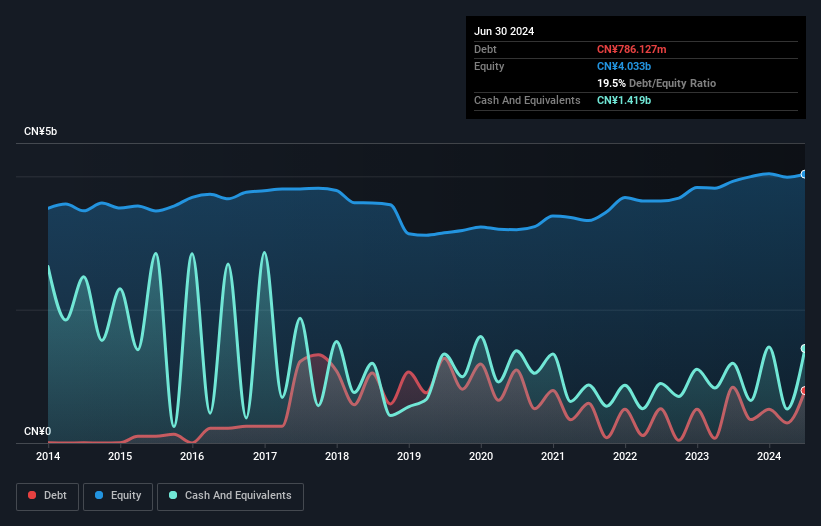Solareast Holdings (SHSE:603366) Has Debt But No Earnings; Should You Worry?
Solareast Holdings (SHSE:603366) Has Debt But No Earnings; Should You Worry?
Warren Buffett famously said, 'Volatility is far from synonymous with risk.' It's only natural to consider a company's balance sheet when you examine how risky it is, since debt is often involved when a business collapses. We can see that Solareast Holdings Co., Ltd. (SHSE:603366) does use debt in its business. But should shareholders be worried about its use of debt?
禾倫·巴菲特曾經說過,「波動性與風險遠非同義詞。」 當您評估風險時,自然會考慮公司的資產負債表,因爲往往在企業倒閉時涉及債務。 從我們可以看到日出東方控件有財務負債。 但股東們應該擔心其債務使用嗎?
What Risk Does Debt Bring?
債務帶來了什麼風險?
Debt and other liabilities become risky for a business when it cannot easily fulfill those obligations, either with free cash flow or by raising capital at an attractive price. In the worst case scenario, a company can go bankrupt if it cannot pay its creditors. However, a more frequent (but still costly) occurrence is where a company must issue shares at bargain-basement prices, permanently diluting shareholders, just to shore up its balance sheet. Of course, plenty of companies use debt to fund growth, without any negative consequences. The first thing to do when considering how much debt a business uses is to look at its cash and debt together.
當一個公司不能通過自由現金流或以有吸引力的價格籌集資本來輕鬆履行債務和其他負債時,債務和其他負債對一個公司來說變得有風險。在最壞的情況下,如果一個公司無法償還債權人,就會破產。然而,更常見的情況是公司必須以白菜價發行股票,永久性地稀釋股東權益,以支持其資產負債表。當然,很多公司使用債務來資助增長,而沒有任何負面影響。在考慮一個企業使用多少債務時,首先要看它的現金和債務的結合。
How Much Debt Does Solareast Holdings Carry?
日出東方控件承擔了多少債務?
As you can see below, Solareast Holdings had CN¥786.1m of debt at June 2024, down from CN¥835.8m a year prior. But it also has CN¥1.42b in cash to offset that, meaning it has CN¥632.5m net cash.
正如您下面所看到的,日出東方控件在2024年6月的債務爲78610萬人民幣,比去年的83580萬人民幣有所減少。 但它也有14.2億人民幣現金來抵消,這意味着它淨現金63250萬人民幣。

How Healthy Is Solareast Holdings' Balance Sheet?
日出東方控件的資產負債表有多健康?
We can see from the most recent balance sheet that Solareast Holdings had liabilities of CN¥2.80b falling due within a year, and liabilities of CN¥143.6m due beyond that. On the other hand, it had cash of CN¥1.42b and CN¥560.9m worth of receivables due within a year. So it has liabilities totalling CN¥966.7m more than its cash and near-term receivables, combined.
從最近的資產負債表可以看出,日出東方有着28億人民幣的短期到期負債,以及14360萬人民幣的長期到期負債。另一方面,它有14.2億人民幣的現金和56090萬人民幣的應收款項,其中一年內到期。 因此,它的負債總額比其現金和短期應收款項的總額高出96670萬人民幣。
While this might seem like a lot, it is not so bad since Solareast Holdings has a market capitalization of CN¥3.58b, and so it could probably strengthen its balance sheet by raising capital if it needed to. But we definitely want to keep our eyes open to indications that its debt is bringing too much risk. Despite its noteworthy liabilities, Solareast Holdings boasts net cash, so it's fair to say it does not have a heavy debt load! When analysing debt levels, the balance sheet is the obvious place to start. But you can't view debt in total isolation; since Solareast Holdings will need earnings to service that debt. So when considering debt, it's definitely worth looking at the earnings trend. Click here for an interactive snapshot.
雖然這看起來可能很多,但並不算太糟糕,因爲日出東方的市值爲35.8億人民幣,所以如果有需要,它可能通過增加資本來加強資產負債表。 但我們絕對要注意其負債是否帶來了太多風險。 儘管其顯著負債,日出東方擁有淨現金,因此可以說它的債務負擔並不重!在分析債務水平時,資產負債表是明顯的起點。 但你不能孤立地看待債務;因爲日出東方將需要盈利來還債務。 因此,在考慮債務時,絕對值得關注盈利趨勢。 點擊這裏查看互動快照。
In the last year Solareast Holdings wasn't profitable at an EBIT level, but managed to grow its revenue by 16%, to CN¥4.9b. We usually like to see faster growth from unprofitable companies, but each to their own.
在過去一年中,日出東方在EBIt水平上沒有盈利,但其營業收入增長了16%,達到49億人民幣。 我們通常希望看到虧損公司實現更快的增長,但每個人有每個人的看法。
So How Risky Is Solareast Holdings?
那麼,日出東方有多大風險?
While Solareast Holdings lost money on an earnings before interest and tax (EBIT) level, it actually booked a paper profit of CN¥173m. So taking that on face value, and considering the cash, we don't think its very risky in the near term. Until we see some positive EBIT, we're a bit cautious of the stock, not least because of the rather modest revenue growth. There's no doubt that we learn most about debt from the balance sheet. But ultimately, every company can contain risks that exist outside of the balance sheet. For example - Solareast Holdings has 3 warning signs we think you should be aware of.
儘管日出東方在息稅前利潤(EBIT)水平上虧損,但實際上錄得了17300萬人民幣的名義利潤。 因此,就表面價值而言,並且考慮到現金,我們認爲在短期內沒有太大風險。 在我們看到一些積極的EBIt之前,我們對這支股票有些謹慎,尤其是因爲其收入增長相當有限。 毫無疑問,我們從資產負債表中可以了解債務的大部分情況。 但最終,每家公司都可能存在超出資產負債表以外的風險。 例如 - 日出東方有3個警告信號,我們認爲你應該注意。
Of course, if you're the type of investor who prefers buying stocks without the burden of debt, then don't hesitate to discover our exclusive list of net cash growth stocks, today.
當然,如果您是那種喜歡購買沒有債務負擔的股票的投資者,那麼不要猶豫,立即發現我們獨家的淨現金增長股票列表。
Have feedback on this article? Concerned about the content? Get in touch with us directly. Alternatively, email editorial-team (at) simplywallst.com.
This article by Simply Wall St is general in nature. We provide commentary based on historical data and analyst forecasts only using an unbiased methodology and our articles are not intended to be financial advice. It does not constitute a recommendation to buy or sell any stock, and does not take account of your objectives, or your financial situation. We aim to bring you long-term focused analysis driven by fundamental data. Note that our analysis may not factor in the latest price-sensitive company announcements or qualitative material. Simply Wall St has no position in any stocks mentioned.
對本文有任何反饋?對內容有任何疑慮?請直接與我們聯繫。或者,發送電子郵件至editorial-team@simplywallst.com。
這篇文章是Simply Wall St的一般性文章。我們根據歷史數據和分析師預測提供評論,只使用公正的方法論,我們的文章並不意味着提供任何金融建議。文章不構成買賣任何股票的建議,也不考慮您的目標或您的財務狀況。我們的目標是帶給您基本數據驅動的長期關注分析。請注意,我們的分析可能不考慮最新的價格敏感公司公告或定性材料。Simply Wall St沒有任何股票頭寸。

 We can see from the most recent balance sheet that Solareast Holdings had liabilities of CN¥2.80b falling due within a year, and liabilities of CN¥143.6m due beyond that. On the other hand, it had cash of CN¥1.42b and CN¥560.9m worth of receivables due within a year. So it has liabilities totalling CN¥966.7m more than its cash and near-term receivables, combined.
We can see from the most recent balance sheet that Solareast Holdings had liabilities of CN¥2.80b falling due within a year, and liabilities of CN¥143.6m due beyond that. On the other hand, it had cash of CN¥1.42b and CN¥560.9m worth of receivables due within a year. So it has liabilities totalling CN¥966.7m more than its cash and near-term receivables, combined.